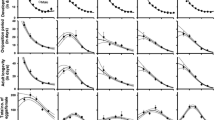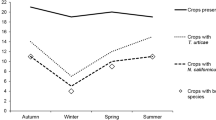Abstract
The tomato red spider mite, Tetranychus evansi, is reported as a severe pest of tomato and other solanaceous crops from Africa, from Atlantic and Mediterranean Islands, and more recently from the south of Europe (Portugal, Spain and France). A population of the predaceous mite Phytoseiulus longipes has been recently found in Brazil in association with T. evansi. The objective of this paper was to assess the development and reproduction abilities of this strain on T. evansi under laboratory conditions at four temperatures: 15, 20, 25 and 30°C. The duration of the immature phase ranged from 3.1 to 15.4 days, at 30 and 15°C, respectively. Global immature lower thermal threshold was 12.0°C. Immature survival was high at all temperatures tested (minimum of 88% at 30°C). The intrinsic rate of increase (r m) of P. longipes ranged from 0.091 to 0.416 female/female/day, at 15 and 30°C, respectively. P. longipes would be able to develop at a wide range of temperatures feeding on T. evansi and has the potential to control T. evansi populations.
Similar content being viewed by others
References
Aucejo S, Foo M, Gimeno E, Gomez A, Monfort R, Obiol F, Prades E, Ramis M, Ripolles JL, Tirado V (2003) Management of Tetranychus urticae in citrus in Spain: acarofauna associated to weeds. IOBC/WPRS Bull 26:213–220
Badii MH (1981) Experiments on the dynamics of predation of Phytoseiulus longipes on the prey Tetranychus pacificus (Acarina: Phytoseiidae, Tetranychidae). University of California, Riverside. PhD Thesis. 153 p
Badii MH, McMurtry JA (1983) Effect of different foods on development, reproduction and survival of Phytoseiulus longipes (Acarina: Phytoseiidae). Entomophaga 28(2):161–166
Birch LC (1948) The intrinsic rate of natural increase of an insect population. J Anim Ecol 17:15–26
Blair BW (1989) Laboratory screening of acaricides against Tetranychus evansi Baker & Pritchard. Crop Prot 8:212–216
Bolland HR, Gutierrez J, Flechtmann CHW (1998) World catalogue of the spider mite family (Acari: Tetranychidae). Brill, Leiden, 392 p
Bolland HR, Vala F (2000) First record of the spider mite Tetranychus evansi (Acari: Tetranychidae) from Portugal. Entomol Berichten 60(9):180
Bonato O (1999) The effect of temperature on life history parameters of Tetranychus evansi (Acari: Tetranychidae). Exp Appl Acarol 23:11–19
Castagnoli M, Nannelli R, Simoni S (2006) Un nuovo temibile fitofago per la fauna italiana: Tetranychus evansi (Baker e Pritchard) (Acari: Tetranychidae). Inf Fitopatol 5:50–52 (in Italian)
Escudero LA, Ferragut F (2005) Life-history of predatory mites Neoseiulus californicus and Phytoseiulus persimilis (Acari: Phytoseiidae) on four spider mite species as prey, with special reference to Tetranychus evansi (Acari: Tetranychidae). Biol Control 32:378–384
Ferragut F, Escudero LA (1999) Tetranychus evansi Baker & Pritchard (Acari: Tetranychidae), una nueva araña roja en los cultivos hortícolas españoles. Bol San Veg Plagas 25(2):157–164 (in Spanish)
Furtado IP (2006) Sélection d’ennemis naturels pour la lutte biologique contre Tetranychus evansi Baker & Pritchard (Acari: Tetranychidae) en Afrique. Agro-Montpellier, France. PhD thesis, 135 p (in French)
Furtado IP, Moraes GJ de, Kreiter S, Tixier M-S, Knapp M (2006a) Potential of a Brazilian population of the predatory mite Phytoseiulus longipes as a biological control agent of Tetranychus evansi (Acari: Phytoseiidae, Tetranychidae). Biol Control, submitted
Furtado IP, Moraes GJ de, Kreiter S, Knapp M (2006b) Search for effective natural enemies of Tetranychus evansi in south and southeast Brazil. Exp Appl Acarol 40(3–4):157–174
Gerson U, Smiley RL, Ochoa R (2003) Mites (Acari) for pest control. Blackwell Science, Oxford (UK), 539 p
Gotoh T, Yamaguchi K, Mori K (2004) Effect on life history of the predatory mite Amblyseius (Neoseiulus) californicus (Acari: Phytoseiidae). Exp Appl Acarol 32(1–2):15–30
Janssen A, Sabelis MW (1992) Phytoseiid life histories, local predator-prey dynamics, and strategies for control of tetranychid mites. Exp Appl Acarol 14:233–250
Ma W-L, Laing JE (1973) Biology, potential for increase and prey consumption of Amblyseius Chilenensis (Dosse) (Acarina: Phytoseiidae). Entomophaga 18(1):47–60
Maia A, Luiz AJB, Campanhola C (2000) Statistical inference on associated fertility life table parameters using Jackknife technique: computational aspects. J Econ Entomol 93(2):511–518
McMurtry JA, Croft BA (1997) Life-styles of phytoseiid mites and their roles in biological control. Ann Rev Entomol 42:291–321
Migeon A (2005) Un nouvel acarien ravageur en France: Tetranychus evansi Baker et Pritchard. Phytoma 579: 38–43 (in French)
Moraes GJ de, McMurtry JA (1985) Comparison of Tetranychus evansi and Tetranychus urticae (Acari: Tetranychidae) as prey for eight species of phytoseiid mites. Entomophaga 30(4):393–397
Moraes GJ de, McMurtry JA (1986) Suitability of the spider mite Tetranychus evansi as prey for Phytoseiulus persimilis. Entomol Exp Appl 40:109–115
Moraes GJ de, McMurtry JA (1987) Effect of temperature and sperm supply on the reproductive potential of Tetranychus evansi. Exp Appl Acarol 3:95–107
Moraes GJ de, Mcmurtry JA, Denmark HA, Campos CB (2004) A revised catalog of the mite family Phytoseiidae. Zootaxa 434. Magnolia Press. Auckland, New Zealand, 494 p
R project (2006) The R manuals. Edited by the R Development Core Team. Current Version: 2.4.0 (October 2006). http://www.r-project.org
Sabelis MW (1985) Capacity for population increase. In: Spider mites, Their Biology, Natural Enemies and Control, vol 1B: 35–41. Helle W. & Sabelis M.W., Elsevier, Amsterdam
Saunyama GM., Knapp M (2003) Effect of pruning and trellising of tomatoes on red spider mite incidence and crop yield in Zimbabwe. Afr Crop Sci J 11(4):269–277
Takahashi F, Chant DA (1992) Adaptative strategies in the genus Phytoseiulus Evans (Acari: Phytoseiidae). I. Developmental times. Int J Acarol 18(3):171–176
Takahashi F, Chant DA (1994) Adaptative strategies in the genus Phytoseiulus Evans (Acari: Phytoseiidae). II. Survivorship and reproduction. Int J Acarol 20(2):87–97
Zhang Z-Q (2003) Mites of greenhouses, Identification, Biology and Control. CABI, London, 244 p
Acknowledgements
This collaborative research between the Red Spider Mite Project at ICIPE, ESALQ/USP and ENSAM/INRA was funded by a grant of the German Federal Ministry for Economic Cooperation and Development (BMZ) to ICIPE.
Author information
Authors and Affiliations
Corresponding author
Rights and permissions
About this article
Cite this article
Ferrero, M., de Moraes, G.J., Kreiter, S. et al. Life tables of the predatory mite Phytoseiulus longipes feeding on Tetranychus evansi at four temperatures (Acari: Phytoseiidae, Tetranychidae). Exp Appl Acarol 41, 45–53 (2007). https://doi.org/10.1007/s10493-007-9053-6
Received:
Accepted:
Published:
Issue Date:
DOI: https://doi.org/10.1007/s10493-007-9053-6




